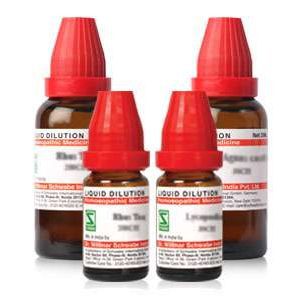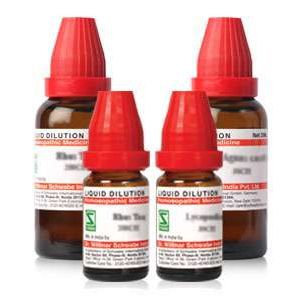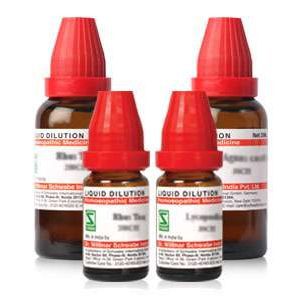Doctors Zone
Journal (JEBH)
Alpha™- Liv Drops
Alpha – Liv Drops Due to high demand from the market, for a formulation in drops for the liver, apart from the syrup already available in the market, Schwabe India developed this product. Introduction The liver plays a key role in metabolism. It has anabolic and catabolic, exocrine and endocrine functions. The liver is a blood reservoir, filter and store of different substances (e.g. glycogen, vitamins). It is the site of serum protein (e.g. albumin, prothrombin, fibrinogen) and enzyme synthesis. Metabolic processes (e.g. bilirubin, hormone, carbohydrate and lipid turnover) and the removal of toxic products are important liver functions. 1 Hepatotoxins (e.g. alcohol, tetracycline, acetaminophen, fungal toxins, and anabolic steroids) can cause specific damage to liver cells. Toxic hepatitis may be clinically silent or severe enough to lead to the rapid development of hepatic failure. Clinical features include hepatomegaly, enzyme abnormalities, fever, abdominal pain, anorexia, nausea, vomiting and weight loss. In patients with underlying cirrhosis, manifestations of portal hypertension may predominate. Aversion to fatty food, abdominal discomfort, nausea and vomiting after meals may be symptoms of 2 cholelithiasis. Jaundice results from accumulation of bilirubin. It has non-hepatic as well as hepatic causes. Hyperbilirubinaemia may be due to abnormalities in the 3 formation, transport, metabolism or excretion of bilirubin. TM Alpha -Liv Drops aids recovery and normalisation of liver functions. Severe liver disease needs specialised treatment. Indications: Slow liver functions, fatty liver, and for supportive treatment of hepatocellular jaundice and toxic liver damage.

Research news – Schwabe News Volume 5 | Issue 1 | January 2014
Schwabe News Volume 5 | Issue 1 | January 2014
Research news
Treatment of nervous complaints and exhaustion with the homoeopathic medicinal product Manuia® (DHU) – results of a cohort study
Manuia® is a product of Deutsche Homöopathie-Union (DHU), homoeopathic division of Dr. Willmar Schwabe, Germany, for exhaustion, nervousness and decreased physical and mental capability. These are some of the conditions recurrently challenging physicians. They are often resulting from overexertion, or disturbed sleep. Nowadays people feel exhausted and weak due to continuously increasing professional demands and rising challenges in daily life. The approved homoeopathic medicinal product Manuia is used in the mentioned therapeutic area. It contains four single active substances viz. Damiana ɸ, Panax ginseng ɸ, Acidum phosphoricum D2 and Ambra grisea D3. Similar product is available from Schwabe India. Damiaplant contains Damiana and Ginseng among others and used in above indications. Acidum phosphoricum is available in mother solution and Ambra grisea is available in 6CH. So far, effectiveness and tolerability of Manuia® were confirmed by clinical experience. This study was conducted by scientifically and systematically collecting data.
The clinical effectiveness and tolerability of Manuia was systematically investigated in a prospective, multicentre, non-interventional cohort study, between January and June 2011. A total of 420 patients were observed by 76 German physicians in private practices. Median observation period was 24 days, median duration of symptoms since diagnosis 5 months. As main outcome measure severity course of 20 symptoms (nervousness, irritability, sleep disturbances, hyperactivity, impaired concentration, listlessness, frustration, moroseness, exhaustion, dispiritedness, decreased capability, feeling of heteronomy, feeling lonely, feeling pressure to perform, feeling excessive demands, forgetfulness, gastrointestinal complaints, cardiovascular complaints, muscle tension, headache) was evaluated with a 5-item score (0 = not present; 4 = very severe). In addition physicians’ Clinical Global Impression (CGI), patients’ quality of life and ability to actively attend different domains of daily’s life, and tolerability of Manuia® were documented.
The sum score as well as the severity of each single symptom decreased significantly during the observations’ period (p<0.01, paired t-test). Illness severity measured by CGI decreased significantly (p<0.01, McNemar test; CGI 4-7: 71.7% to 35.2%). Ability to work and to attend social and family life improved significantly (p<0.01, McNemar test). In 77.1% (n=324 out of 420) of the patients quality of life was good, very good or excellent during control visit, compared to 15.8% (n=66 out of 420) at baseline. 92.4% of the patients rated their condition as improved, 64.1% as much or very much improved. Median duration until onset of action was 7 days. Tolerability was good or very good in 98.1% of all cases.
The study data underlined the existing good clinical experience with Manuia and suggests Manuia as a therapeutic option in the treatment of nervous complaints and exhaustion. Further controlled studies are necessary to confirm these findings.
Reference:
- J. Wilkens, P. Klement, Treatment of nervous complaints and exhaustion with the homoeopathic medicinal product Manuia® – results of a cohort study, Homeopathy, Volume 103, Issue 1, January 2014, Pages 73
High-dilution effects revisited – Physicochemical aspects & Pharmacodynamic mechanisms
This article is published in two parts in the same issue. The first part discusses with the physicochemical aspects and the second part deals with the pharmacodynamic mechanisms of high dilutions. Several lines of evidence suggest that homoeopathic high dilutions (HDs) can effectively have a pharmacological action, and so cannot be considered merely placebos. However, until now there has been no unified explanation for these observations within the dominant paradigm of the dose–response effect. Here the possible scenarios for the physicochemical nature of HDs are reviewed. A number of theoretical and experimental approaches, including quantum physics, conductometric and spectroscopic measurements, thermoluminescence, and model simulations investigated the peculiar features of diluted/succussed solutions. The heterogeneous composition of water could be affected by interactive phenomena such as coherence, epitaxy and formation of colloidal nanobubbles containing gaseous inclusions of oxygen, nitrogen, carbon dioxide, silica and, possibly, the original material of the remedy. It is likely that the molecules of active substance act as nucleation centres, amplifying the formation of supramolecular structures and imparting order to the solvent. Three major models for how this happens are currently being investigated: the water clusters or clathrates, the coherent domains postulated by quantum electrodynamics, and the formation of nanoparticles from the original solute plus solvent components. Other theoretical approaches based on quantum entanglement and on fractal-type self-organization of water clusters are more speculative and hypothetical. The authors concluded that the current evidence strongly supports the notion that the structuring of water and its solutes at the nanoscale can play a key role.
In the second part the pharmacodynamics aspects of homoeopathic remedies were supported by the explained by laboratory studies on the biological effects at various levels (cellular, molecular and systemic). The major question is how these medicines may work in the body. The possible answers concern the identification of biological targets, the means of drug–receptor interactions, the mechanisms of signal transmission and amplification, and the models of inversion of effects according to the traditional ‘simile’ rule. These problems are handled by two experimental and theoretical lines, according to the doses or dilutions considered (low-medium versus high dilutions). Homoeopathic formulations in low-medium dilutions, containing molecules in the range of ultra-low doses, exploit the extreme sensitivity of biological systems to exogenous and endogenous signals. Their effects are interpreted in the framework of hormesis theories and paradoxical pharmacology. The hypotheses regarding the action mechanisms of highly diluted/dynamized solutions (beyond Avogadro–Loschmidt limit) variously invoke sensitivity to bioelectromagnetic information, participation of water chains in signalling, and regulation of bifurcation points of systemic networks. High-dilution pharmacology is emerging as a pioneering subject in the domain of nanomedicine and is providing greater plausibility to the puzzling claims of homoeopathy.
Reference:
- Paolo Bellavite, Marta Marzotto, Debora Olioso, Elisabetta Moratti, Anita Conforti, High-dilution effects revisited. 1. Physicochemical aspects & 2. Pharmacodynamic mechanisms, Homeopathy, Volume 103, Issue 1, January 2014
Disclaimer
The information provided herein is not intended to be taken as a replacement for medical advice and should not be used during any medical emergency. A Registered Medical Practitioner should be consulted for diagnosis and treatment of any and all medical conditions. Links to other sites are provided for information only and they do not constitute endorsements of those other sites.
If you want to receive regular e-mail updates, you can directly subscribe now.
Recent Advancements in Basic Homeopathic Research – A Report on Two Significant Publication
In a study conducted at the Experimental Farm of the State University of Santa Catarina, Brazil, researchers investigated the impact of homeopathic treatments on piglets during the nursery phase. The study aimed to determine whether homeopathic agents could reduce fighting behavior, improve growth performance, and affect hematological, metabolic, and oxidative variables. The study included 108 weaned piglets divided into four groups: a negative control group receiving only the basal diet, and three groups receiving different homeopathic treatments at varying dosages.
Journal of Evidence Based Homeopathy Volume: 1, Issue: 1, January - June 2023
Comprehensive articles

Agrohomeopathy – A Review
Short cases

Unmasking the Intricacies: A Pyogenic Abscess Case Report

Lichen Simplex: A Singular Case Study

Ranula Unveiled: A Case Report and Management Approach

Lichen Simplex: A Singular Case Study

A Puzzling Presentation: A Case Report of Jaundice
Recent provings and updated materia medica

Acidum Formicum

Mygale

Thea Chinensis
Materia medica on phytohomeopathy

Chrysarobinum

Sanguinarinum nitricum

Thiosinaminum
Mother tincture

Asparagus Officinalis

Ginkgo Biloba

Rosmarinus Officinalis
Product watch

Alpha™- Liv Drops

Good Morning™ Constipation Drops

Zauber™ Hair Drops
Research News




























